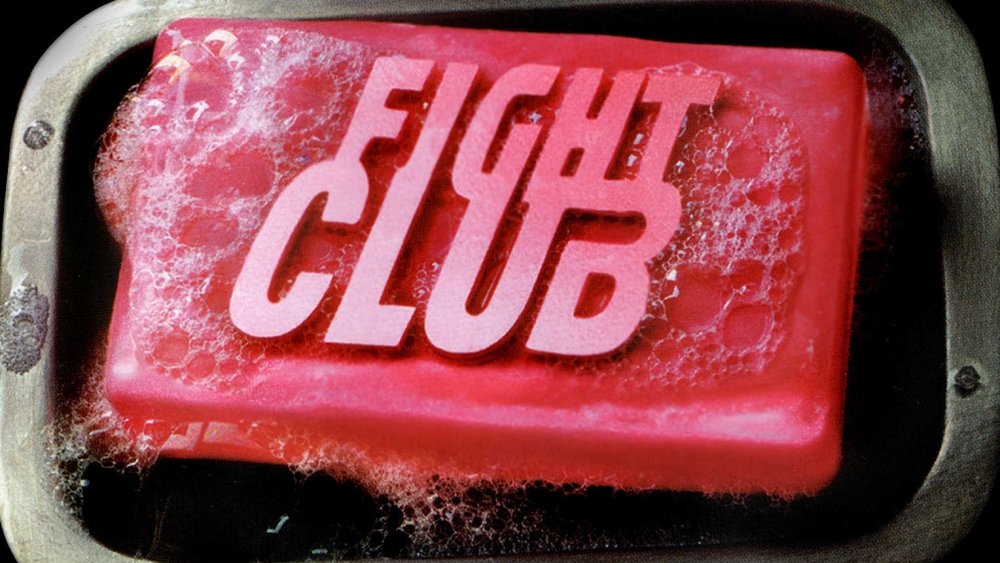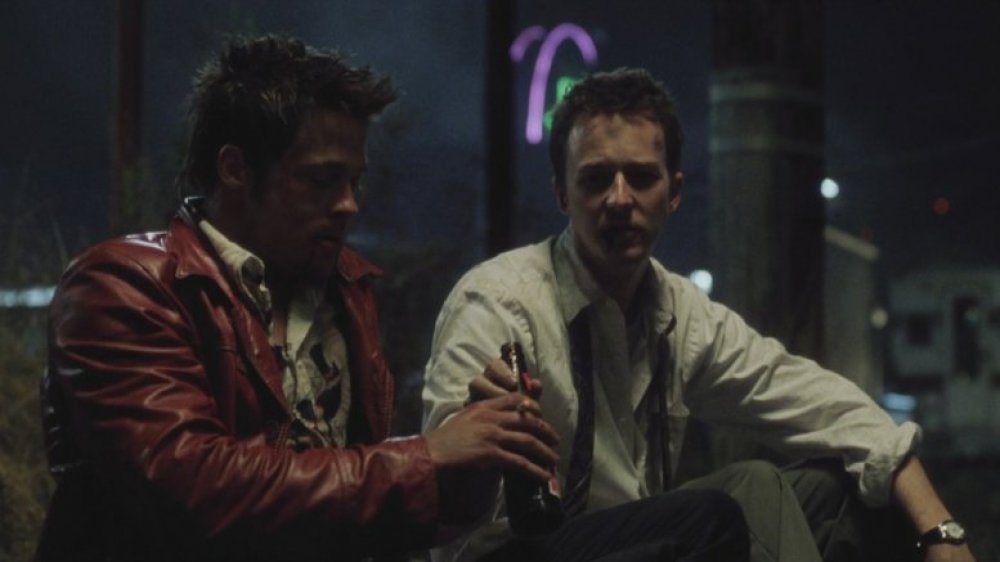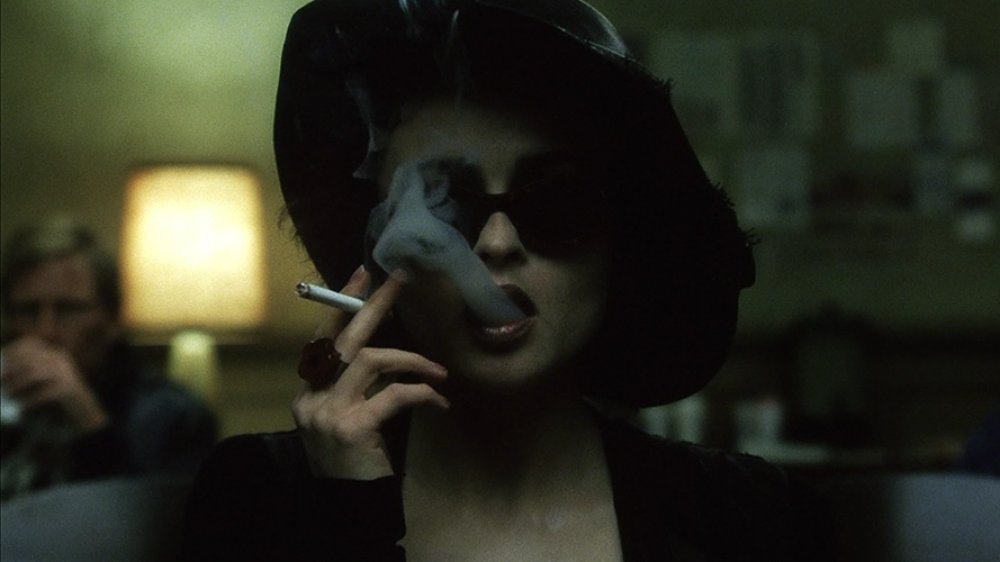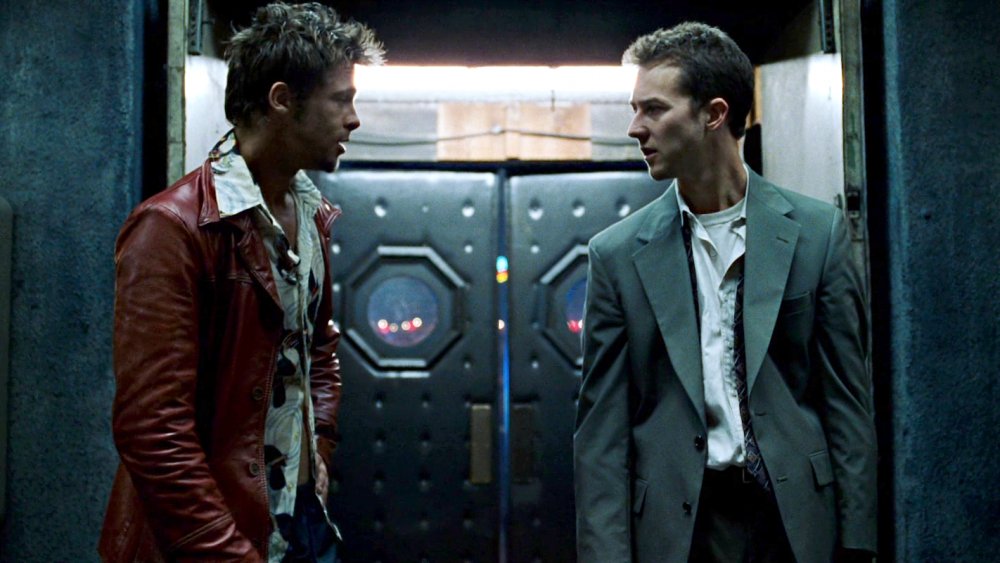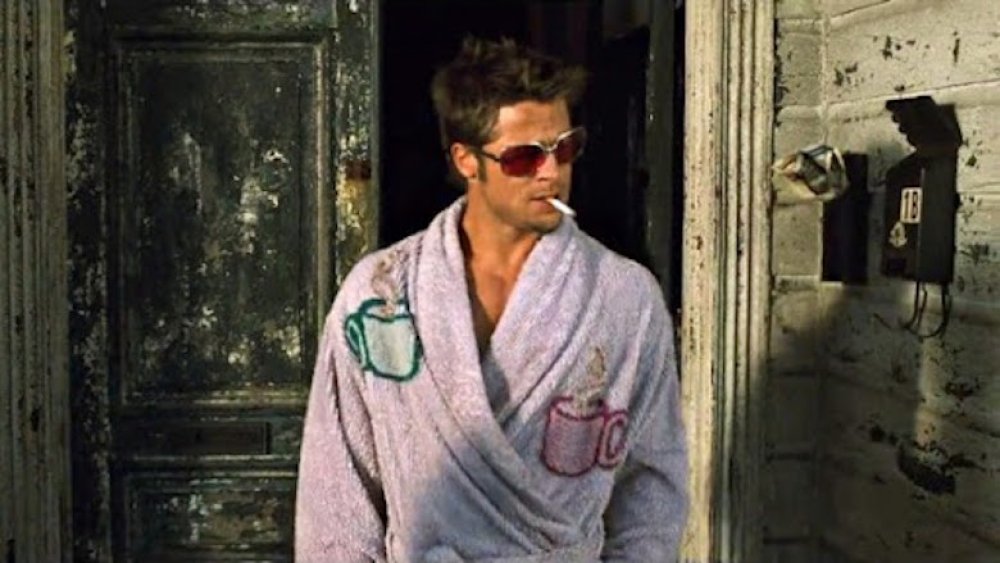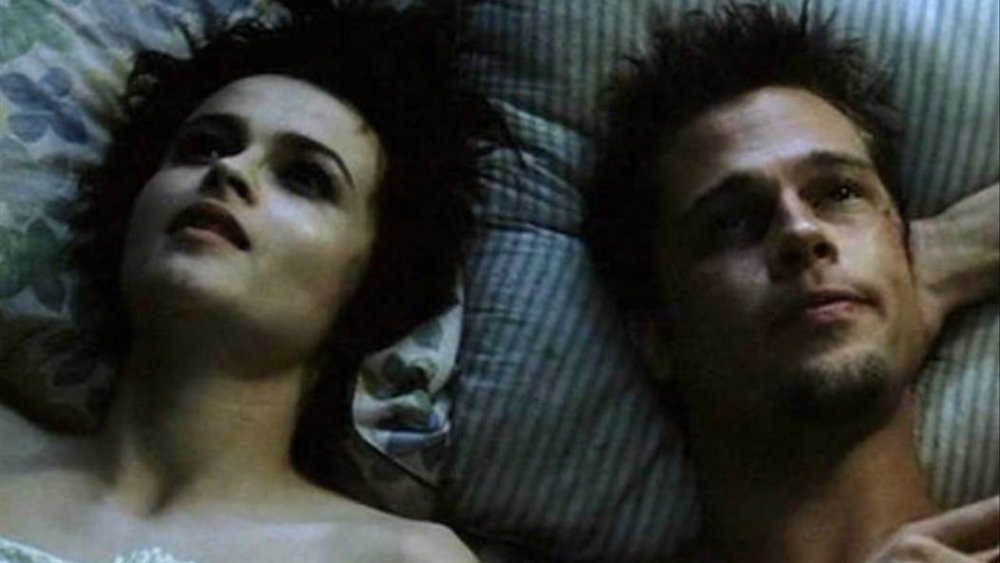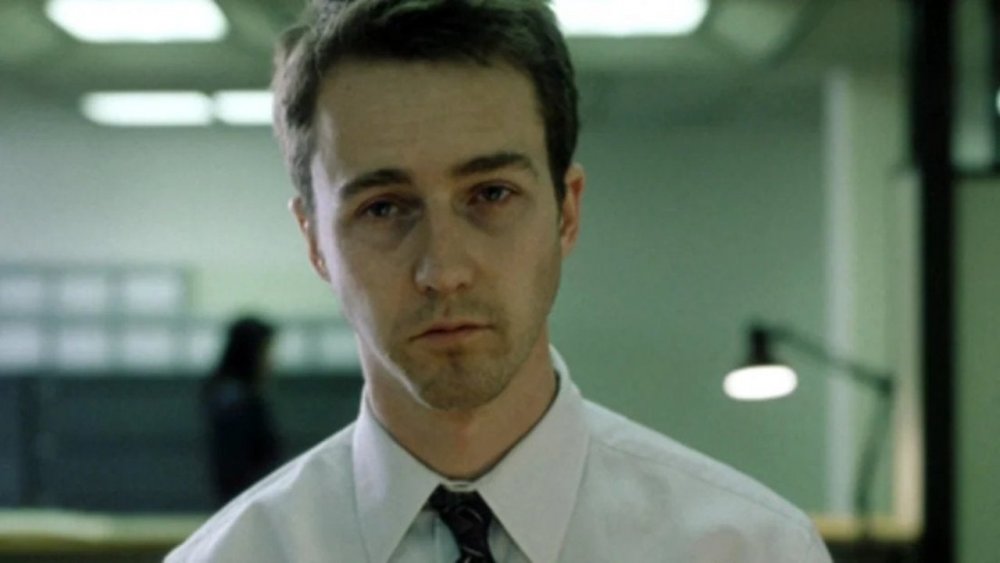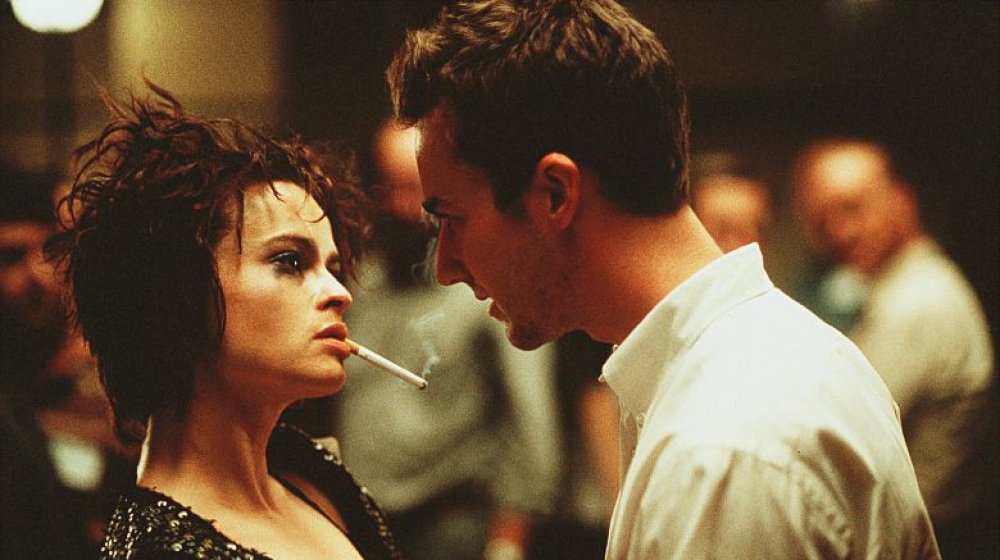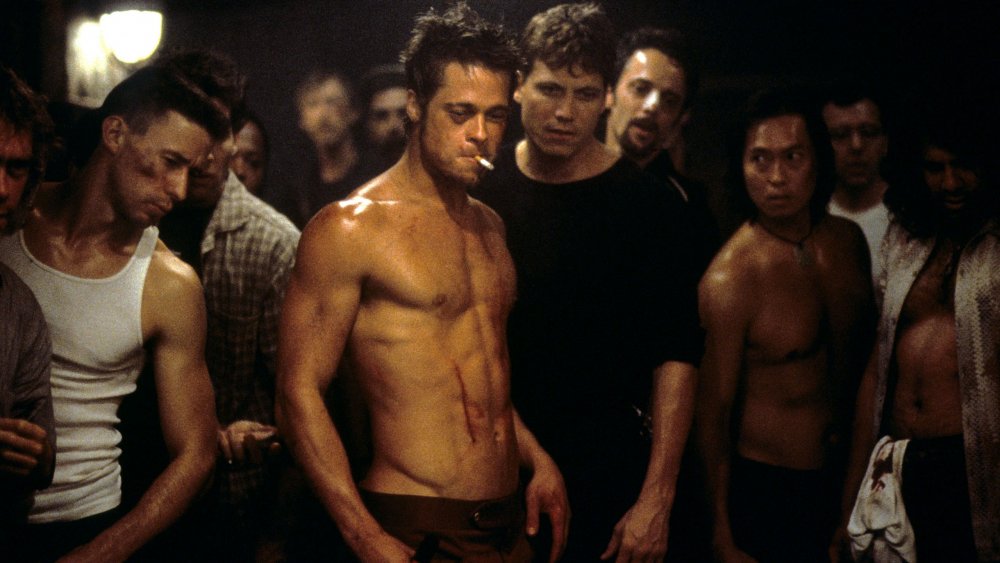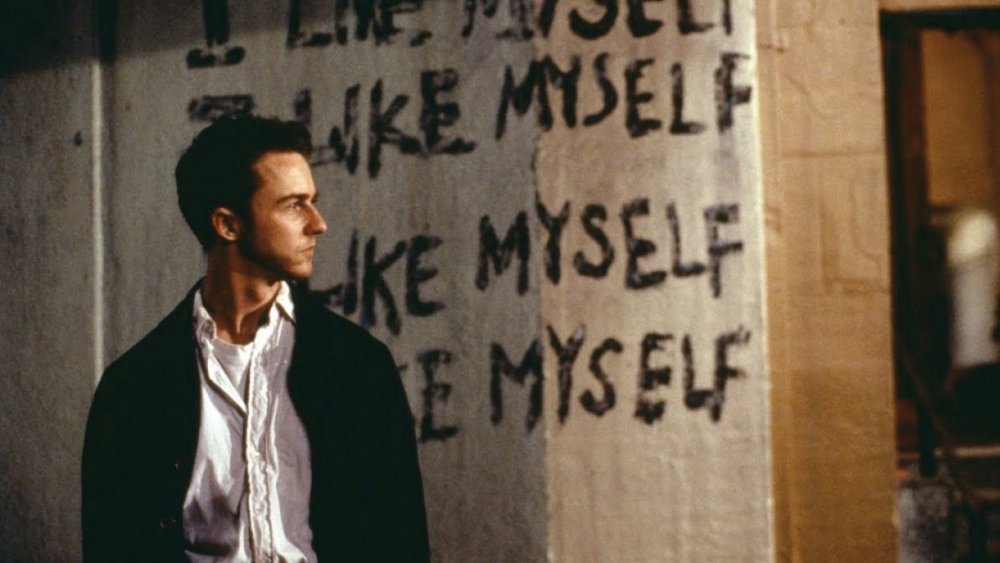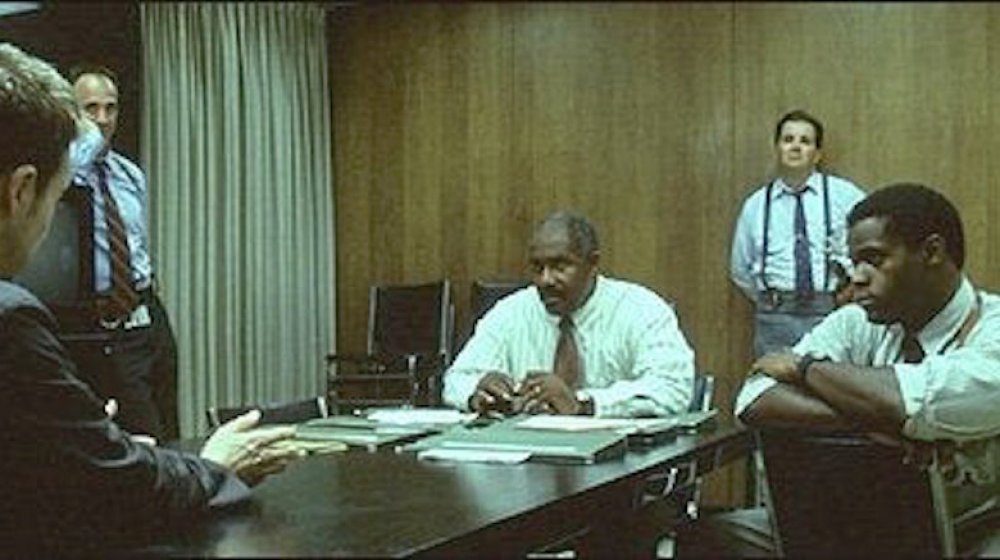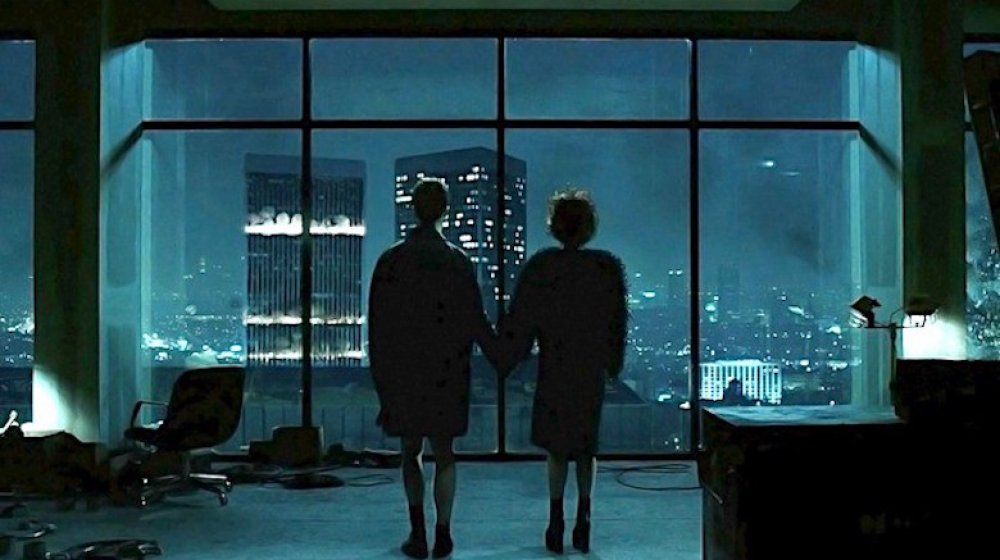The Untold Truth Of Fight Club
Fight Club's induction into pop-culture history was neither easy nor assured. With its release postponed because of the Columbine school shooting and a weak debut at the box office, this highly quotable masterpiece took its sweet time taking over the cultural zeitgeist. Directed by David Fincher and based on the novel of the same name by Chuck Palahniuk, Fight Club tells the story of an insomniac insurance adjuster and the soap-making leader of an underground men's boxing club who turn out to be the same person. Featuring Edward Norton as the morose Narrator, Brad Pitt as his charismatic alter ego, and Helena Bonham-Carter as the catalyst who sparks the two men's social revolution, the film is a tornado of action, humor, and horror.
In time, Fight Club became recognized as the smart, shocking satire it is. Nowadays, we all know the rules of Fight Club, the New York Times hails it as a defining cult-classic, and Tyler Durden has name recognition on par with Tony Stark and Rick Blaine. But for as beloved as the film has become, there's still a lot most don't know about it. This is the untold truth of Fight Club, from DVD sales to novelty bathrobes.
The could-have-beens of Fight Club
David Fincher was not the first choice to direct Fight Club. Other directors offered the position include Peter Jackson, Bryan Singer, and Danny Boyle. That's not the only role that might have gone to other talents, however.
For the role of enigmatic Tyler Durden, Russell Crowe was considered. Matt Damon and Sean Penn were on deck for the Narrator. For the part of chain-smoking potty-mouth Marla Singer, the choices included Janeane Garofalo, Reese Witherspoon, Winona Ryder, Courtney Love, and even Julia Louis-Dreyfus, whose Elaine Benes on Seinfeld has major Marla Singer vibes. Garofalo claims Norton didn't want to work with her, and Love was dating Norton at the time. Louis-Dreyfus had no idea who David Fincher was, and Witherspoon and Ryder seemed too young. Helena Bonham-Carter had reservations about singing on, but after she met with Fincher and understood his agenda, she got on board. Thus, Fight Club as we would come to know it was assembled.
Getting messy on set
Life on the Fight Club set wasn't easy. Fincher is famous for filming dozens and dozens of takes, only to end up using the first one. He also expects a great deal of realism, so Helena Bonham-Carter really was smoking during those many months of shooting, including Fincher's multiple takes to get the now-iconic smoke swirling around her face just right. She ended up getting a terrible case of bronchitis because of it.
Brad Pitt was not one to be one-upped by Bonham-Carter's method smoking, however: He actually had his perfect teeth chipped for Fight Club. His snaggle-toothed smile appears towards the end of the movie. Pitt's girlfriend at the time, Jennifer Aniston, even shaved his head for the film at home.
Unsurprisingly, there were a huge number of injuries sustained on set. For example, the scene toward the end where Tyler throws the Narrator down the stairs and through the toll booth was filmed by Ed Norton's stunt double dozens of times, until Brad Pitt grew concerned he was actually getting hurt. Since they didn't hire professional boxers, everyone on set was constantly jamming fingers and joints. Both Pitt and Norton started developing similar injuries as filming went on — a brutal, if appropriate symbol of their characters' relationship.
Iconic moments, courtesy of Pitt and Norton
Tyler and the Narrator's first fight wasn't as choreographed as others in the movie. When Tyler screams "Why the ear?!" it's because the punch came as a fictional and real-world surprise — the excellent line is an ad-lib on Pitt's part.
That's just one of many moments of chemistry created by Pitt and Norton. As they would note years later, they came up with the idea of smashing the then-new streamlined version of the Volkswagen Beetle specifically. Why? As Norton told Salon, "There's the perfect example of the baby-boomer generation marketing its youth culture to us as if our happiness is going to come by buying the symbol of their own youth movement." Salon went even further, asking, "But isn't the VW bug the perfect example of boomers peddling their youth to themselves?" Fight Club is all about encouraging that sort of questioning — and the whole conversation is thanks to Norton and Pitt's brilliant idea.
Elaborate costuming
Having worked on Blade Runner and Flashdance, costume designer Michael Kaplan found himself helping Helena Bonham-Carter understand Marla through wardrobe choices. "Think Judy Garland for the millennium. Not the actress in The Wizard of Oz – think Judy Garland later on, when she was a bit of a mess, drinking and doing drugs while her life was falling apart," Kaplan told Bonham-Carter. Her smoky eye makeup and smeared lipstick deliberately mirror the bruises on her co-stars' faces, and she even had her makeup artist use her left hand so the effect would be perfectly mussed.
For Tyler Durden's look, Kaplan turned to more and more outlandish outfits that eventually include a red leather jacket and a see-through mesh shirt, as well as a secondhand Victoria's Secret bathrobe.
While both Tyler and Marla are fans of thrift store shopping, the Narrator begins with a wardrobe filled with generic-looking suits. As the movie progresses, he grows more and more grungy, just as Tyler becomes ever more outrageous and colorful. This relationship is mirrored in their shifting physiques: As Tyler gains muscle, the Narrator grows more and more frail. The alter ego acts as a parasite, siphoning away more and more of its host.
How one of the most disturbing lines in Fight Club came to be
Fight Club is chock-full of one-liners. But one of the most memorably disturbing lines is deployed by Marla Singer after a particularly satisfying tryst with Tyler Durden: "I haven't been f***ed like that since grade school." But this was not the line in Chuck Palahniuk's novel or the original screenplay. In those, Marla says, "I want to have your abortion."
Producer Laura Ziskin asked Fincher to change to original line. She and other Fox executives didn't want to give picketers another reason to target the movie. But in an extremely Tyler Durden-ish move on Fincher's part, he made Ziskin promise that whatever he changed the line to, she would have to accept. No conditions, no take-backs. When she heard the replacement line, Fincher said she visibly cringed and begged him to return to the original script.
Marla's post-coital nastiness stayed in the film. The irony is that Laura Ziskin was herself responsible for scripting a pivotal line in Pretty Woman – "She rescues him right back." This immortal utterance changes the entire tone of the movie, just as Marla's line changes Fight Club.
Norton's own philsophizing
Edward Norton had just turned 30 when filming on Fight Club began, and he found himself deeply connected to the material. Norton was very aware of the generation gap Fight Club exposed between Baby Boomers and their Gen X children, who were disillusioned by the world they'd inherited. "I'm not saying nobody over the age of 45 understood the film -– that's ludicrous, lots of people deeply appreciated it –- but I think for the same reasons a lot of Baby Boomers didn't understand Nirvana, they didn't understand Fight Club. I think a lot of the Baby Boomers looked at their children and said, 'Why so negative?' I don't think they related to the ambivalence of our generation."
Norton also agrees with the film's anti-capitalist and anti-consumerist messages, going so far as to say Fight Club is Gen X's The Catcher in the Rye. "I think the Fight Club is kind of metaphoric for the fight against your own impulses to get cocooned in things," he remarked soon after the film's debut. "Which is why, when the guys fight, they get up and hug each other at the end and thank each other for the experience. It's the gesture that's helping them strip away the fears; the fears of pain and the reliance on the material signifiers of their self-worth." This is Jack's mind blown.
A clash with critics
Many critics saw Fight Club as promoting and glorifying violence. But, like the book on which it's based, Fincher insists that Fight Club is actually a social satire that critiques violence and toxic masculinity in American society. As Fincher told a concerned Dr. Drew, "There are ideas in the movie that are scary, but the film isn't about violence, the glorification of violence, or the embracing of violence. In the movie, violence is a metaphor for feeling. It's a film about the problems or requirements involved with being masculine in today's society." Fincher even went so far as to tell Entertainment Weekly, "I've always thought people would think the film was funny. It's supposed to be satire. A dark comedy. I think it's funny."
Screenwriter Jim Uhls takes Fincher's analysis even further, telling Salon that he wrote and continues to see Fight Club as a romantic comedy, "but not a typical romantic comedy. It has to do with the characters' attitudes toward a healthy relationship, which is a lot of behavior which seems unhealthy and harsh to each other, but in fact does work for them — because both characters are out on the edge psychologically." It's not the most widespread reading of the film, but it's definitely one of the most thought-provoking.
Chuck Palahniuk's take
Chuck Palahniuk sold the film rights to Fight Club for $10,000 — and that's after his publishing deal gave him just $6,000 for the book. These are shockingly low numbers for a story that has become a cornerstone of modern fiction. Palahniuk's novel was inspired by a variety of personal experiences: His colleagues ignoring bruises sustained by getting jumped, his time as a hospice care worker, and his experiences working in manufacturing. Its power lies in its honesty, and the film respects that truth.
Unlike most screenplays, Fight Club lifts almost all of its dialogue from Palahniuk's novel. But there is a major divergence in the two endings: In the book, Jack gets institutionalized, whereas in the movie, Tyler Durden makes himself whole while sparking a revolution. Even so, Palahniuk has mentioned being startled they didn't take the film adaptation even further: "I actually wish they'd taken more license with the book and surprised me a little bit more." He also admits that the screenplay is better than his novel and now finds himself "embarrassed" by the book's writing. He especially appreciates how screenwriter Jim Uhls streamlined his story, making a number of internal connections he himself had missed.
Pivotal DVD sales
Fight Club had a budget of $60 million, but only brought in $37 million during its theatrical run in North America. However, once everyone started breaking those first two rules of Fight Club and word of mouth spread, Fight Club ended up recouping its box office losses with DVD sales. Fight Club is ripe for multiple re-watches, rewarding viewers who linger over it for significant lengths of time. Thus it became an odd poster child for the DVD boom of the early 2000s. It certainly helped that Fincher included hours of extras, including interviews, gags, behind-the-scenes footage, and commentaries from the cast and crew.
In 2009, a new edition of Fight Club found its way to Blu-ray for the movie's 10th anniversary. In Durden-esque style, it features a number of gags that had people trying to return their purchases, thinking they'd been sold the wrong movie. The Blu-ray opens with the title cards for another romantic comedy released in 1999, Never Been Kissed, a movie that also features dual identities. It's a perfect prank, and a tribute to all the fans who've brought Fight Club home over the years, making it into the cult classic it is today.
Three detectives with one name
Towards the end of Fight Club, as the Narrator comes to terms with his identity as the founder of Project Mayhem, he finds himself at the downtown offices of the Los Angeles Police Department, attempting to turn himself in. But the three cops present — Detective Andrew, Detective Kevin, and Detective Walker — are actually members of Fight Club. Tyler warned them this would happen, and told them to take the Narrator out of the picture entirely through ritual castration.
Andrew Kevin Walker was one of Fincher's writers on Seven, and he came in at the end to help polish up the Fight Club script. Fincher said Walker had done 20% of the "heavy lifting" of rewrites and deserved a writing credit, but the Writers Guild of America disagreed and denied him attribution on the film. So Fincher and company named the three cops after him, in a Tyler Durden-esque middle finger to the WGA.
Fight clubs of the real world
When it comes to satire, there is always a risk that the action being critiqued will be taken at face value. Fight Club, unfortunately, was primed to fall victim to this — and did. Ever since it hit theaters, actual fight clubs have sprung into being all over the world. They have existed in Menlo Park, California, Arlington, Texas, and New Jersey, in a particularly grotesque example that involved adults at a daycare getting children to fight each other. Moreover, it's not just fight clubs being imitated. In 2009, a New York teenager planned to bomb a Starbucks in emulation of Tyler Durden. Sadly, these folks totally miss the point: The movie is criticizing toxic masculinity, not promoting or encouraging it. In other words, Tyler Durden is not a role model.
In comments to the New York Times, Fincher said, "Women maybe get the humor faster," and noted that Fight Club's female fans better identify and understand the film's message. Perfectly riffing off this dynamic, a 2010 viral comedy sketch called "Jane Austen's Fight Club" highlights the different ways women approach the original story. It's not Tyler Durden's bag, but we think he might approve.
